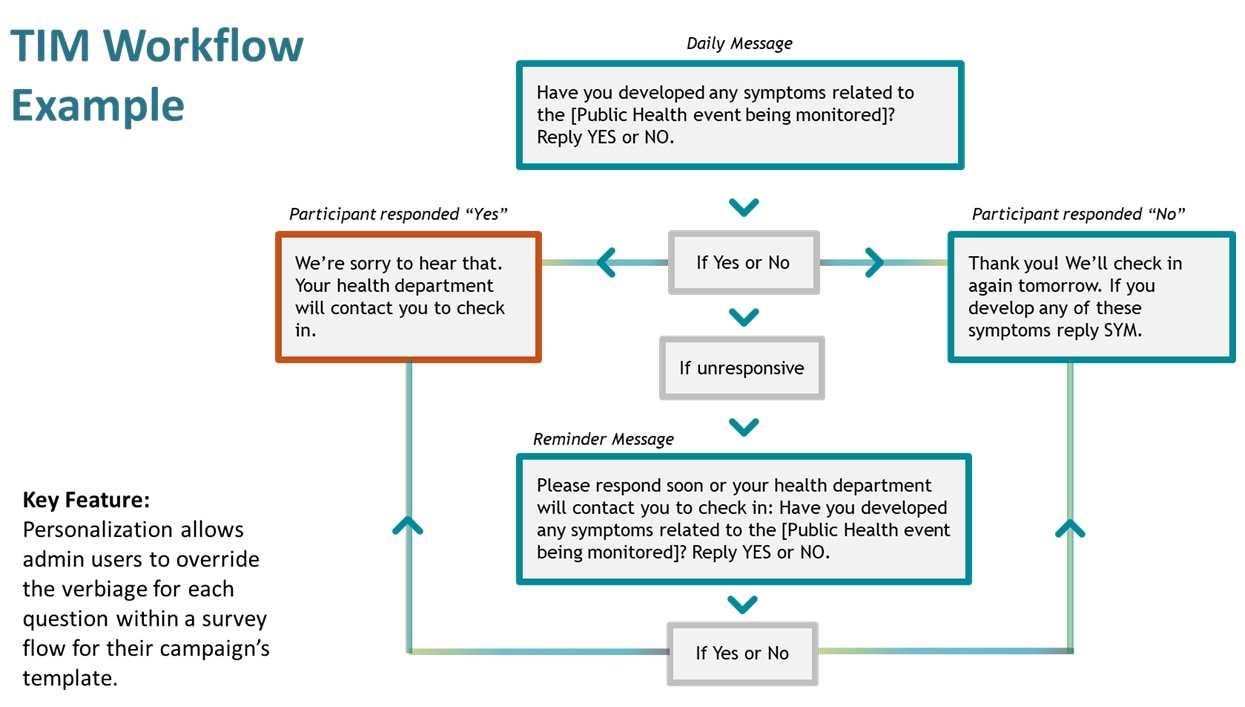Frequently Asked Questions
Access
State, Tribal, Local, and Territorial public health authorities may request access to TIM by completing the form found on the Contact Us page. The TIM support team will work with the requesting organization to provide access to TIM.
Yes, Local jurisdictions can use TIM for infectious disease outbreak symptom monitoring and messaging.
Public health administrators at the State, Tribal, or Territorial level can access all data within their jurisdiction, including Local data. Jurisdictions assigned at the Local level will only have access to the data for the jurisdiction to which they are assigned. CDC does not have access to participant data.
Dashboards and Notifications
The TIM platform includes a dashboard with multiple visualizations, including detailed and summary information on monitored individuals and alerts that require attention (e.g., those who reply YES to a text indicating they have a symptoms or those who have not responded to reminder texts). For alerts, jurisdictions can view the name and mobile phone number associated with the alert and the content of the text message.
TIM creates an alert when an enrolled participant:
- Responds with a text that they have symptoms
- Does not respond to the daily message after a reminder
- Sends a text message to opt out
Administrators may log into TIM to view all alerts for participants. Each organization may also set up users to receive alert notifications via email.
There are several reports and data extracts available in TIM.
- Campaign Report (PDF document): Graphics on participant status, campaign status, and alerts at the time the report was generated
- Participant Report (PDF document): History of all the text responses received and alerts over a specified time for a participant
- Participant download extract (CSV file): Detailed information on all enrolled participants
- Responses download extract (CSV file): List of participant responses and time stamps over a specified time
- Alerts download extract (CSV file): Detailed information on all alert records generated within a campaign
In addition to reports and extracts, TIM includes a dashboard with summary information about participants, texting campaigns, and alerts displayed as graphs and tables. The data in these graphs and tables can be exported as a CSV file.
Enrollment and Messaging
Organizations using TIM can personalize the text message workflow template available in the system based on their needs. Figure 1 in TIM Workflow Example shows a sample of a text message template available in TIM. After the organization adds a participant’s mobile phone number to TIM, the participant will immediately receive a welcome message notifying them of their enrollment. Participants will receive a daily message asking whether they have symptoms consistent with the identified infectious disease outbreak and will be prompted to reply, ‘Yes’ or ‘No.’ If a participant does not respond to the daily message, the TIM system will send a reminder. At the end of the monitoring period, participants will receive a final message informing them that they have completed monitoring and will be unenrolled from TIM.
Figure 1. TIM Workflow Example


TIM Workflow Example (flow chart description): Daily message: Have you developed any symptoms related to the [Public Health event being monitored]? Reply YES or NO.
- If “YES”, we’re sorry to hear that. Your health department will contact you to check in.
- If “NO”, thank you! We’ll check in again tomorrow. If you develop any of these symptoms reply SYM.
- If unresponsive, send reminder message: Please respond soon or your health department will contact you to check in: Have you developed any symptoms related to the [Public Health event being monitored]? Reply YES or NO
- Refer back to Daily message response
Key Feature: Personalization allows admin users to override the verbiage for each question within a survey flow for their campaign’s template. Survey frequency can be set for 14- or 21-days monitoring allowing customizable monitoring templates.
The only information required to enroll a participant in TIM is a mobile phone number. Participants may also enter their name.
Yes, there is flexibility to edit the text messages in the template. This can include the signs and symptoms listed in the daily question and other messages to meet the needs of the population being monitored. Users can also change the monitoring period for the participants.
Infrastructure
TIM has high privacy standards and includes only minimal personally identifiable information (PII) to support monitoring efforts. Data stored in TIM include participant’s mobile phone number, name (if entered), number of days remaining in the monitoring period, and a history of text message responses (including content, date, and time). Administrators can also enter and edit notes for specific participant alerts.
TIM uses standard Security Development Lifecycle (SDL) principles, embedding security requirements into every phase of development. Standards defined by Amazon Web Services (AWS) are also in place to help protect customer data in accordance with PII and The Health Insurance Portability and Accountability Act of 1996 (HIPAA) guidelines. The upgraded platform is hosted in AWS cloud centers. Connections established between users and the data centers are encrypted, and all public endpoints are secured using industry-standard Transport Layer Security (TLS). TLS effectively establishes a security-enhanced browser-to-server connection using Hypertext Transfer Protocol Secure (HTTPS) to help ensure data confidentiality and integrity between desktops and data centers. Unauthorized traffic is blocked to and within AWS datacenters. The infrastructure is constantly maintained, enhanced, and verified by AWS, and regular penetration testing is employed to continually validate the performance of security controls and processes. Monitoring campaigns are created and maintained by separate agency profiles in TIM. Users can only see PII for campaigns created by the agency to which they have been given account access. PII is maintained and stored for as long as the end user requires; users can request for the data to be deleted at any time.
For more information, please contact us at timsupport@cdc.gov.